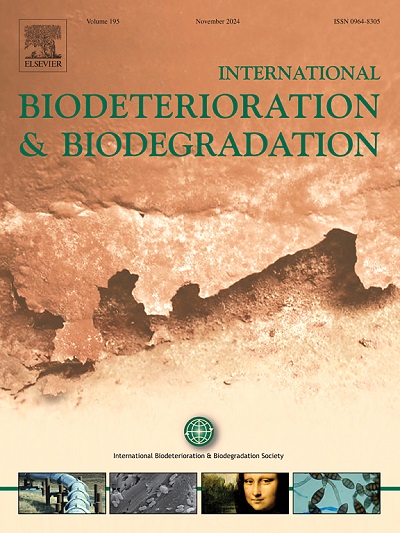Reaction zone evolution and remediation efficacy evaluation of in-situ biogeochemical transformation of emulsified vegetable oil-FeSO4 enhanced tetrachloroethylene-contaminated aquifers
IF 4.1
2区 环境科学与生态学
Q2 BIOTECHNOLOGY & APPLIED MICROBIOLOGY
International Biodeterioration & Biodegradation
Pub Date : 2025-04-18
DOI:10.1016/j.ibiod.2025.106100
引用次数: 0
Abstract
Enhanced in-situ biogeochemical transformation (ISBGT) has been proven effective in promoting the abiotic β-elimination of chlorinated solvents. However, the mechanisms underlying reaction zone evolution, remediation efficiency, and long-term permeability changes during the remediation process remain poorly understood. This study employed emulsified vegetable oil (EVO) and FeSO4 as amendments to establish an in-situ reaction zone in a simulated column system. The reaction zone evolution was systematically analyzed, and the remediation efficiency and permeability variations in a PCE-contaminated aquifer were assessed. The results showed that after a single injection of EVO-FeSO4, the reaction zone evolved through three distinct stages, including emulsified oil decomposition, microbial reduction, and β-elimination. The formation and aging mechanisms of the sulfur-iron mineral biogeobattery were also clarified. During the 300-day experimental period, the system achieved a PCE removal efficiency of 93.3%, with abiotic degradation processes contributing 96.36% of the total removal. This study provides important insights for the further development and practical application of ISBGT technology.

乳化植物油- feso4增强四氯乙烯污染含水层原位生物地球化学转化反应带演化及修复效果评价
增强原位生物地球化学转化(ISBGT)在促进氯化溶剂的非生物β-消除中具有良好的效果。然而,在修复过程中,反应带演化、修复效率和长期渗透率变化的机制尚不清楚。本研究采用乳化植物油(EVO)和FeSO4作为改性剂,在模拟柱体系中建立了原位反应区。系统分析了反应带演化,评价了pce污染含水层的修复效率和渗透率变化。结果表明,单次注入EVO-FeSO4后,反应区经历了乳化油分解、微生物还原和β消除三个阶段。阐明了硫铁矿生物地电池的形成和老化机理。在300天的实验期间,该系统对PCE的去除率为93.3%,其中非生物降解过程对总去除率的贡献为96.36%。该研究为ISBGT技术的进一步发展和实际应用提供了重要的见解。
本文章由计算机程序翻译,如有差异,请以英文原文为准。
求助全文
约1分钟内获得全文
求助全文
来源期刊
CiteScore
9.60
自引率
10.40%
发文量
107
审稿时长
21 days
期刊介绍:
International Biodeterioration and Biodegradation publishes original research papers and reviews on the biological causes of deterioration or degradation.

 求助内容:
求助内容: 应助结果提醒方式:
应助结果提醒方式:


